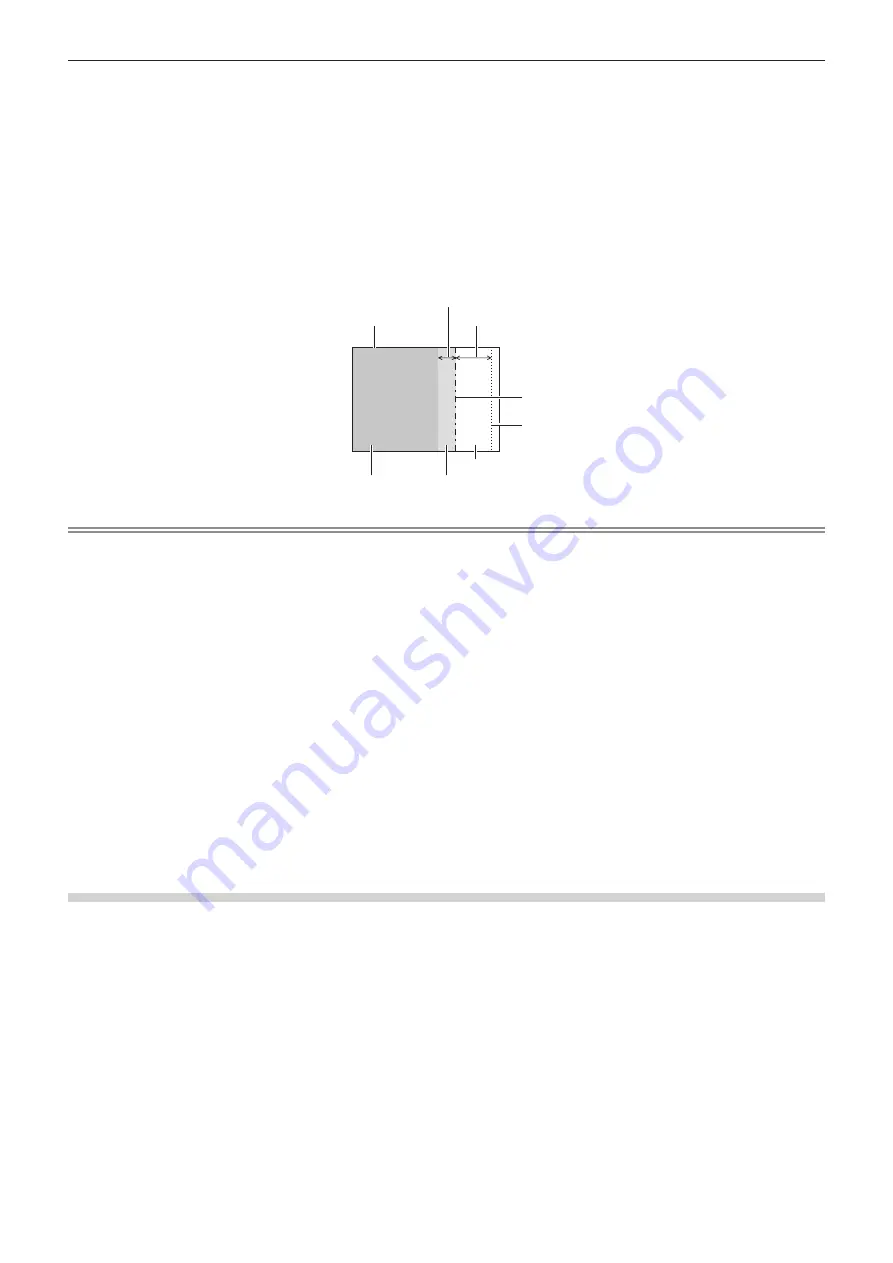
Chapter 4
Settings — [ADVANCED MENU] menu
120 - ENGLISH
32) Press
as
to select an item, and press
qw
to adjust the setting.
f
Once the adjustment is completed, press the <MENU> button to return to the
[BLACK LEVEL ADJUST]
screen.
33) Press
as
to select [UPPER], [LOWER], [LEFT], or [RIGHT] for [OVERLAPPED BLACK LEVEL].
34) Press the <ENTER> button.
f
The adjustment area in the projected image becomes temporarily bright and the
[OVERLAPPED BLACK
LEVEL]
screen is displayed.
f
[RED], [GREEN], and [BLUE] can be adjusted individually if [INTERLOCKED] is set to [OFF].
35) Press
as
to select an item, and press
qw
to adjust the setting.
[BLACK BORDER AREA] (Right)
Projection range
Edge blending [WIDTH] (Right)
[MARKER] (Red)
Edge blending [START] (Right)
([MARKER] (Green))
[BLACK BORDER LEVEL]
[OVERLAPPED BLACK LEVEL] (Right)
[NON-OVERLAPPED BLACK LEVEL]
Note
f
It is recommended to select [GEOMETRY UNLINKED] when using the projector in following conditions.
g
Project an image to a flat screen.
g
Combine projected images from multiple projectors in vertical column or horizontal row.
f
[BLACK LEVEL ADJUST] is a function that makes the increased brightness in black level of the overlapping image area difficult to
notice when [EDGE BLENDING] is used to structure a multi-display screen. The optimal point of correction is set by adjusting [NON-
OVERLAPPED BLACK LEVEL] so that the black level of the overlapping image area will be the same level as the non-overlapping area. If
the border area of the part where the image is overlapping and the non-overlapping part gets brighter after adjusting [NON-OVERLAPPED
BLACK LEVEL], adjust the width or the shape of the top, bottom, left, or right. Adjust [BLACK BORDER LEVEL] when the adjustment makes
only the border area darker.
f
The joining part may look discontinuous depending on the position you are looking from when a screen with high gain or rear screen is used.
f
When configuring multiple screens using both horizontal and vertical edge blending, adjust [OVERLAPPED BLACK LEVEL] first before
making adjustments in Step
16)
. Adjustment method is same as the procedure of [NON-OVERLAPPED BLACK LEVEL].
f
If only horizontal or vertical edge blending is used, set all items in [OVERLAPPED BLACK LEVEL] to 0.
f
The [AUTO TESTPATTERN] setting will change in conjunction with the setting in the [DISPLAY OPTION] menu
→
[COLOR MATCHING]
→
[AUTO TESTPATTERN].
f
Adjustment of the shape of the border between [NON-OVERLAPPED BLACK LEVEL] and [BLACK BORDER LEVEL] is a function to
perform the edge blending together with the adjustment of [GEOMETRY] (
x
page 110). If [NON-OVERLAPPED BLACK LEVEL] is
deformed by correcting the distortion of the projected image with [GEOMETRY], perform the adjustment following Step
21)
to Step
29)
, and
adjust the edge blending according to the shape of [NON-OVERLAPPED BLACK LEVEL].
f
An error is accumulated by repeatedly adjusting the position of the adjustment points, which may distort the shape of the border awkwardly.
In such a case, initialize the shape of the border. Initializing the shape of the border will reset the shape to the factory default (unadjusted
state). For details, refer to “Initializing the shape of the border” (
x
page 120).
Initializing the shape of the border
Initialize the data adjusted with [UPPER FREE SHAPE], [LOWER FREE SHAPE], [LEFT FREE SHAPE], and
[RIGHT FREE SHAPE] and restore to the factory default settings (unadjusted state).
1) Press
as
to select [EDGE BLENDING].
2) Press
qw
to select [ON] or [USER].
3) Press the <ENTER> button.
f
The
[EDGE BLENDING]
screen is displayed.
4) Press
as
to select [BLACK LEVEL ADJUST].
5) Press the <ENTER> button.
f
The
[BLACK LEVEL ADJUST]
screen is displayed.
6) Press
as
to select [UPPER FREE SHAPE], [LOWER FREE SHAPE], [LEFT FREE SHAPE], or [RIGHT
FREE SHAPE] to initialize.






























